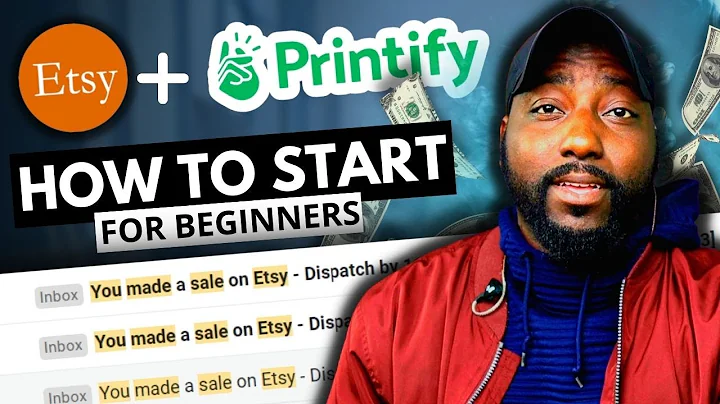Build a Profitable Custom Art Store: Step-by-Step Guide
Table of Contents:
- Introduction
- The Problem with Drop Shipping
- The Profitable Business Model of Selling Personalized Art
- Finding the Right Art Style to Sell
- Researching Successful Companies
- Finding Designers to Work With
- Building Your Store
- Importance of Reviews
- Personalization Apps for Your Store
- Setting up Email Flows
- Marketing Your Product
- Tips for Increasing Sales and Organizing Orders
- Conclusion
Article: How to Build a Profitable Custom Art Store from Scratch
Have you ever considered starting your own online store, specifically selling customized art? In this article, I will take you through every step of the process, providing you with valuable insights and tips to help you bootstrap a successful art store from scratch. As someone who currently runs multiple personalization stores specializing in selling art, I am well-versed in the intricacies of this business model. Trust me when I say that selling personalized art can be one of the most profitable ventures in 2022. However, it is important to navigate through the complexities of this industry with a clear roadmap. So let's dive in and explore the world of custom art stores!
The Problem with Drop Shipping
Before we delve into the details of building a custom art store, let's address the elephant in the room: drop shipping. While drop shipping has been a popular business model, it is important to acknowledge its limitations, particularly when it comes to selling products from China. Drop shipping products from China can often result in subpar quality and delayed shipments, leading to dissatisfied customers and a lack of control over the products being delivered. If you want to establish a long-term profitable brand, it is essential to have full control over the products you sell. This is where the business model of selling personalized art comes into play.
The Profitable Business Model of Selling Personalized Art
Selling personalized art offers a unique and profitable business opportunity. The concept is simple: when a customer places an order, all you have to do is forward the order to a designer who will create the desired art file. Once the artwork is ready, it can be sent to the customer as a digital file, giving you complete control over the product and its delivery. Additionally, you have the potential to upsell additional items such as framed posters or pillows using a print-on-demand (POD) company. This business model eliminates the uncertainties and challenges associated with drop shipping, allowing you to build a brand that focuses on quality and customer satisfaction.
Finding the Right Art Style to Sell
Choosing the right art style to sell is crucial for the success of your custom art store. Start by conducting research on popular art styles using platforms like Fiverr. By searching for keywords such as "custom portrait" and sorting the results by best selling, you can gain insights into the current market demand. Look for styles with high-ranking listings and a considerable number of reviews. This indicates a strong demand for those particular art styles, giving you an opportunity to tap into a profitable niche.
Researching Successful Companies
Once you have identified a promising art style, it's time to research companies that are already selling products in that style. Analyze their success indicators, such as customer reviews, social media presence, and advertising efforts. By understanding what makes these companies successful, you can gain valuable insights and apply similar strategies to your own store. Consider placing test orders to gauge their sales volume and estimate their lifetime revenue. This research will help you validate the viability of your chosen art style and identify potential gaps in the market that you can fill.
Finding Designers to Work With
To deliver high-quality art to your customers, you need talented designers who can bring your customers' visions to life. Fiverr is a great platform to find and collaborate with designers. Once you have identified promising designers, reach out to them and propose a partnership. Many designers are open to working privately and becoming a part of your team. Start by giving them a test order, and if you are satisfied with the quality of their work, negotiate pricing and establish a mutually beneficial long-term relationship. As your business grows, consider expanding your team of designers to meet increasing demand.
Building Your Store
Now that you have the product, art style, and designers in place, it's time to build your store. Building a minimalistic, conversion-oriented store is essential when starting out. There is no need to spend a significant amount of money on website design initially. Instead, focus on creating a store that prioritizes simplicity, ease of navigation, and a smooth purchasing process. Shopify offers a wide range of language options, allowing you to reach a global audience. Consider hiring someone from Fiverr to translate your store and establish a long-term relationship with them for future translation needs.
Importance of Reviews
When starting a new store, customer reviews are crucial for building trust and credibility. Since you won't have any customer reviews initially, a strategy to overcome this hurdle is to gather reviews from competitors' websites. Aim to have around 100 reviews on your store, even if they are obtained from other sources. These reviews serve as social proof and provide potential customers with the confidence they need to make a purchase. As you receive real customer reviews, you can gradually replace the initial reviews obtained from competitors.
Personalization Apps for Your Store
To enhance the personalization aspect of your store and create a smooth customer experience, consider using powerful applications such as Bold Product Options, Looks Reviews, and Upload Kit. Bold Product Options allows you to set up product page options, giving customers the flexibility to customize their orders. Looks Reviews helps make your page appear trustworthy by collecting and showcasing customer reviews. Lastly, Upload Kit allows customers to attach photos to their orders, further enhancing the personalized experience.
Setting up Email Flows
Email flows play a crucial role in engaging with customers, recovering abandoned carts, and nurturing relationships. When starting out, focus on setting up two essential email flows: abandoned cart and welcome series. In the abandoned cart email flow, include a discount code to entice customers to complete their purchases. In the welcome series, offer a discount code as a final push to convert first-time visitors into paying customers. These email flows can be easily set up using email marketing automation tools, such as Klaviyo or Mailchimp.
Marketing Your Product
To drive traffic to your store and generate sales, effective marketing is essential. Facebook ads have proven to be a successful marketing channel for many e-commerce businesses. The advantage of advertising in smaller countries is the lower level of competition, allowing you to reach more people with a smaller budget. Create conversion-oriented ad sets with broad targeting initially, gradually refining your target audience as your store grows. Shoot your own ad creatives, leveraging your personal connection to the products. Letting the designer draw a picture of yourself and using it as an ad creative can be highly effective.
Tips for Increasing Sales and Organizing Orders
Once your store starts receiving orders, it is important to implement strategies to increase sales and effectively manage your workload. Utilize project management tools like Trello to streamline your order management process. Create different sections for orders in progress, completed orders, revisions, and more. As your team of designers grows, assign orders to them and maintain clear communication. Consider implementing upsells, such as offering printed posters along with digital files, to maximize your average order value.
Conclusion
Building a profitable custom art store from scratch requires careful planning, research, and implementation of the right strategies. Selling personalized art offers immense potential for success and profitability. By understanding the nuances of this business model, conducting thorough research, finding talented designers, and leveraging effective marketing techniques, you can create a brand that stands out in the competitive e-commerce landscape. Embrace the power of art and customization, and embark on your journey to a thriving custom art store.
Highlights:
- Selling personalized art is a highly profitable business model.
- Drop shipping from China often leads to quality issues and customer dissatisfaction.
- Research popular art styles and successful companies to find your niche.
- Collaborate with talented designers to bring your customers' visions to life.
- Build a conversion-focused store and prioritize customer reviews for trust-building.
- Use personalization apps and email flows to enhance the shopping experience.
- Optimize your marketing efforts to reach your target audience effectively.
- Implement strategies to increase sales and efficiently manage your orders.
- Trello is an excellent tool for organizing and tracking your orders.
- Upselling additional products can boost your average order value and profits.
FAQ:
Q: Can I sell customized art without using a drop shipping model?
A: Yes, selling personalized art allows you to have full control over the product and its delivery, eliminating the uncertainties of drop shipping.
Q: How can I find the right art style to sell?
A: Research popular art styles and analyze successful companies to identify trends and market demand.
Q: How do I find designers to work with?
A: Platforms like Fiverr are great for finding talented designers. Reach out to them, propose a partnership, and evaluate their skills through test orders.
Q: What strategies can I use to increase sales?
A: Implement upsells, leverage email marketing, and continuously optimize your marketing campaigns to drive more sales.
Q: How can I efficiently manage my orders?
A: Use project management tools like Trello to streamline your order management process and effectively communicate with your team of designers.


















